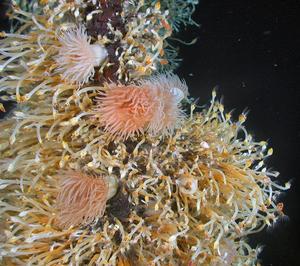The discovery of hydrothermal vents in Antarctic waters has been one of the holy grails of deep-sea biology...
Communities of species previously unknown to science have been discovered on the seafloor near Antarctica, clustered in the hot, dark environment surrounding hydrothermal vents.
Working from the Royal Research Ship James Cook, scientists discovered new species of yeti crab, starfish, barnacles, sea anemones, and potentially an octopus.
Using Isis, the National Oceanography Centre’s deep diving Remotely Operated Vehicle (ROV) scientists explored the East Scotia Ridge, deep beneath the Southern Ocean. Here, hydrothermal vents, (including ‘black smokers’ reaching temperatures of up to 382 degrees Celsius) create a unique environment that lacks sunlight, but is rich in certain chemicals. The team, led by the University of Southampton, University of Oxford and British Antarctic Survey, reports its findings in this week’s issue of the online, open-access journal PLoS Biology.
Hydrothermal vents are home to animals found nowhere else on the planet that get their energy not from the Sun but from breaking down chemicals, such as hydrogen sulphide.
Paul Tyler, Professor of Deep-sea Biology at the University of Southampton, says “The discovery of hydrothermal vents in Antarctic waters has been one of the holy grails of deep-sea biology. This discovery adds an important piece to the jigsaw of understanding vent biogeography and maintenance in the global ocean.”
Highlights from the ROV dives include images showing huge colonies of the new species of yeti crab, thought to dominate the Antarctic vent ecosystem, clustered around vent chimneys. Elsewhere the ROV spotted numbers of an undescribed predatory sea-star with seven arms crawling across fields of stalked barnacles. It also found an unidentified pale octopus, nearly 2,400 metres down, on the seafloor.
The team believe that the differences between the groups of animals found around the Antarctic vents and those found around vents elsewhere suggest that the Southern Ocean may act as a barrier to some vent animals. The unique species of the East Scotia Ridge also suggest that, globally, vent ecosystems may be much more diverse, and their interactions more complex, than previously thought.
Professor Tyler adds “It is imperative that we follow up these discoveries by looking at other remote areas of the global ocean for signs of hydrothermal venting.”
ROV dives were conducted with the help of the crews of RRS James Cook and RRS James Clark Ross. The discoveries were made as part of a consortium project with partners from the University of Southampton, University ofOxford, University of Bristol, Newcastle University, British Antarctic Survey, National Oceanography Centre, and Woods Hole Oceanographic Institution supported by the UK’s Natural Environment Research Council and the US National Science Foundation (NSF).

